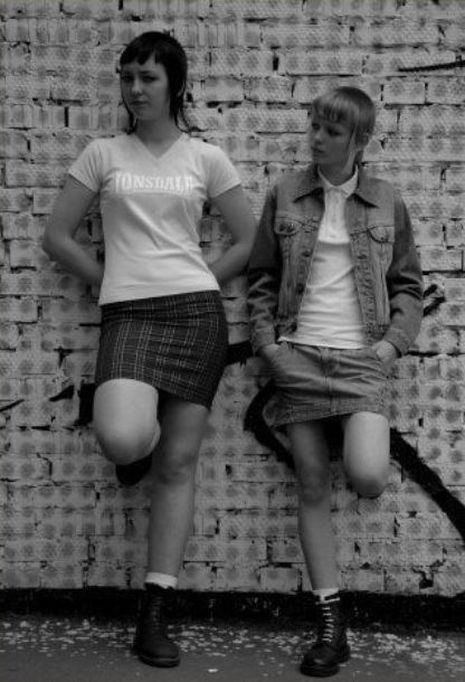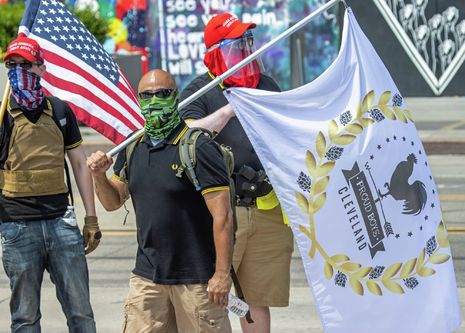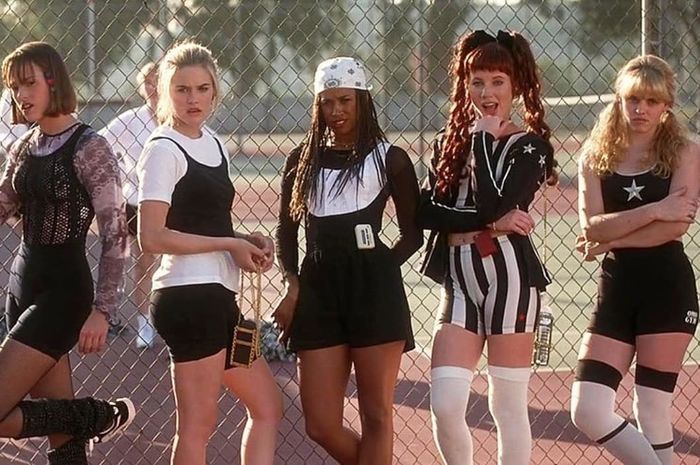Taboo clothing: what to do?
Isabel Sebode wonders how we tackle the appropriation of fashion by far-right supremacist groups and asks if this clothing can or should ever be reclaimed.

Content Note: discussion of Nazism, homophobia and racism
Cultural appropriation is unambiguously offensive. Distancing traditional attire from the ethnic group and refashioning it into a party dress or Halloween costume disregards the centuries of culture that underlie it. Through whitewashing and (perhaps unconsciously) portraying the group as the abnormal ‘other’, the tradition becomes a costume that can be worn next to the vampire and witch, or alternatively, in a nightclub.
Yet, what about a different kind of taboo clothing? In itself unproblematic clothing, which has been perverted by controversial groups into a sign of belonging? Can we, or should we, still wear this?
Let us take the unofficial uniform of supremacist, far-right communities. Instead of wearing overtly apparent Nazi iconography, members are recognised through specific clothing choices that have become indirectly representative of the group. For instance, the popular preppy brand Fred Perry that has been appropriated by the far-right, neo-fascist Proud Boys group. Founded in 2016, Proud Boys supporters express their extremist views in a black Fred Perry shirt with the yellow trim. Thus, this unproblematic shirt has been charged with a racist, sexist and homophobic background, making it unwearable – and thankfully now unbuyable, considering that Fred Perry has responded with taking back sales from the US and Canada.
Another classic element of white supremacy is a pair of black Doc Martens with white or red shoelaces, known to be the staple item in the ‘uniform’ of neo-Nazis. The political charge of this has caused backlash in 2017 when Doc Martens advertised new shoes with red shoelaces – a relatively ordinary combination that nonetheless seems inseparable from its past and present symbolism.
Thus, bomber jackets, combat boots and khakis or jeans seem to complete the Nazi uniform of the modern-day extremists. What strikes me is that there is nothing intrinsically wrong with any of these clothing pieces; each of them can be, and are, worn in isolation (unlike a t-shirt depicting the black sun symbol that would immediately trigger alarm). Only in the combination of the elements is the uniform complete, and seemingly unwearable without risking unwanted, negative responses. The outfit becomes like a sentence, a method communication. The individual words themselves hold close to no power for signification, yet in combination with others, a forceful meaning is created.
"The question is how we shall deal with this racist, alt-right perversion of fashion."
Oppressed social groups reclaiming offensive and controversial signs is not a novel phenomenon. Yet being a white liberal that rebels by wearing the informal neo-Nazi uniform is more complicated. The intents of the former are clear, whilst the intention of the latter may be easily misunderstood.
This seems to show the political power of fashion, which comes with its shortcomings. Wearing clothes for an aesthetic appeal is one thing, and oftentimes the priority, yet, fashion allows and forces us to speak without words. It becomes a social signifier, capturing the passer-by’s attention and giving them an idea of your personality, preferences, mood, class, interests…and perhaps even your political position. From wearing red to the polls on election day in the US, to wearing a Black Lives Matter shirt, fashion speaks for us to everyone – without the use of words.

Yet, taking into account this power of fashion, realistically, what really happens if we do end up wearing the clothes outside of their intended context? We simply strap on some docs with white laces and dark jeans and call it a day? The effect is multifaceted and unfortunately does not lend itself for a straightforward answer. On one hand, the act may be one of liberation from the controversy, as the protestor challenges the negative associations and instead calls attention to the fact that it is merely clothing. The extremist groups are not given the power to pervert fashion into politics.
"Liking Docs does not make you a Nazi. Adding white laces...does?"
The brand Lonsdale successfully made this transition. Being pushed into the extreme-right group’s closet when these discovered that a bomber-jacket half-zipped over the logo t-shirt reveals the letters NSDA (the first four letters of the German Nazi party NSDAP), the brand quickly became connected with the extremist views. In order to salvage their image, Lonsdale directly targeted the issue by launching an elaborate campaign with the slogan ‘Lonsdale loves all colours’. The result was prosperous, considering that many anti-racist, anti-supremacy groups decided to wear the brand in protest, thereby disarming the far-right groups. The masses fought against the masses to shift and change the socially recognised meaning.
Lonsdale’s campaign was strong and effective, yet the brand was also lucky. For, on the other hand, we may equally argue that the wearer is being simple-minded and perhaps even too negligent of the radical views that the clothes stand for. Wearing an outfit that a neo-Nazi might wear is not reclaiming the clothing but equally disrespectful to the people who have suffered from what the group promotes. Ignoring the intrinsic meaning brought about by years of oppression may be seen as ignorance towards the severity of the group itself.
It truly seems as if there is no real ‘right thing’ to do.
It is important to be aware of the precarious decision that a fashion choice may be, yet at the same time distancing us from the issue solely grants power to these groups. Just as the extremist groups managed to subvert the imagery through a mass effort, we can only reclaim the brands and clothing through a collective movement. A single person in a neo-Nazi outfit does not appear to be an effort to reclaim the clothing, but rather an uninformed outfit choice or a contentious political statement.
To make a progressive change we need the masses to act by collectively wearing the clothing for what it is: an outfit, not a destructive choice.
Fashion holds power, yet this force of meaning derives from the power of the masses to generate it. Just as a social influence was used to pervert the brand names, power is needed to undo the change. Thus, the visual force of fashion can only be used for a social good if society actively works towards an accepted change in meaning. Fashion is in constant flux, evolving a secondary language. Like words, idioms or money, this currency of expression is only usable if recognised widely. The meaning of expression may be altered by a social force. The result may be an inevitably lingering political message, either for or against the controversial statement. Fashion is infiltrated with its ability communicate, with the signified only to be lost in history. When that might be, I don’t know, but with the hurtful radical statements thrust on fashion, it is desperately needed.
 News / Cambridge academics stand out in King’s 2026 Honours List2 January 2026
News / Cambridge academics stand out in King’s 2026 Honours List2 January 2026 Interviews / You don’t need to peak at Cambridge, says Robin Harding31 December 2025
Interviews / You don’t need to peak at Cambridge, says Robin Harding31 December 2025 Comment / What happened to men at Cambridge?31 December 2025
Comment / What happened to men at Cambridge?31 December 2025 Features / “It’s a momentary expression of rage”: reforming democracy from Cambridge4 January 2026
Features / “It’s a momentary expression of rage”: reforming democracy from Cambridge4 January 2026 News / AstraZeneca sues for £32 million over faulty construction at Cambridge Campus31 December 2025
News / AstraZeneca sues for £32 million over faulty construction at Cambridge Campus31 December 2025











